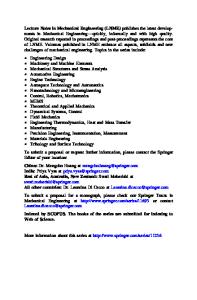Effect of Ceramic Particulate Addition on Aluminium Based Ex-Situ and In-Situ Formed Metal Matrix Composites
- PDF / 4,632,334 Bytes
- 14 Pages / 595.276 x 790.866 pts Page_size
- 44 Downloads / 309 Views
Effect of Ceramic Particulate Addition on Aluminium Based Ex-Situ and In-Situ Formed Metal Matrix Composites B. Gobalakrishnan1 · C. Rajaravi2 · Gobikrishnan Udhayakumar3 · P. R. Lakshminarayanan1 Received: 15 July 2020 / Accepted: 20 August 2020 © The Korean Institute of Metals and Materials 2020
Abstract An attempt was made to synthesis ex-situ formed Al/SiC MMC and in-situ formed Al/TiB2 MMC using stir casting method with different weight percentage of the ceramic particulates such as 4 wt%, 6 wt% and 8 wt% respectively. Significant improvements of mechanical properties were observed when the addition of reinforcement particulates increased from 2 to 8 wt%. The tensile strength and Rockwell hardness of the ex-situ and in-situ formed composites were conducted as per the ASTM standard E08-16 and ASTM standard E18-15 respectively. The in-situ formed T iB2 MMC has superior mechanical properties such as 0.2% proof strength, tensile strength and hardness as compared to ex-situ SiC MMC as well as base metal. It is also concluded that the mechanical properties were increased with increase in wt% of reinforcement particles additions. The Optical Microscopy and Scanning Electron Microscopy were used to examine the size and uniformity of reinforcement particles whereas the Energy Dispersive X-ray analysis, X-ray diffractometer and Element Mapping analysis were used to confirm the presence of TiB2 particles. Keywords MMCs · Al/SiC · Al/TiB2 · Stir casting · Microstructure · Mechanical properties
1 Introduction Many applications require higher strength, hardness, corrosion resistance, wear-resistance and thermal stability, like structural members, IC engine piston and brake shoes need Aluminium with better stiffness, strength with lighter weight. For this reason, castings are made by mixing hard ceramic particles into the molten aluminium matrix and fabricated to form Aluminium based composite materials. [1–5]. Al/SiC MMCs are very stiff at the same time have higher strength to weight ratio and wear resistance. Many aerospace components, sports cars, wear parts, seals and piston rings require lighter materials like Aluminium and magnesium that have higher strength and lighter weight. * B. Gobalakrishnan [email protected] 1
Department of Manufacturing Engineering, Annamalai University, Annamalai Nagar, Tamil Nadu 608 002, India
2
Department of Mechanical Engineering, Vel Tech Multi Tech Dr. Rangarajanm Dr. Sakunthala Engineering College, Chennai, Tamil Nadu 600 062, India
3
Department of Mechanical Engineering, Sona College of Technology, Salem, Tamil Nadu 636 005, India
Aluminium with T iB2 reinforcement formed in-situ has still higher strength, stiffness and most especially good thermal stability when compared to Al/SiC MMCs. These properties make Al/TiB2 MMCs very much attractive. Al/TiB2 MMCs can be competitive to magnesium, presently used material, the melting and fabrication of which is very complicated. Under all these circumstances, Aluminium becomes an attractive choice whether it is ca
Data Loading...










